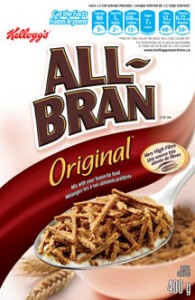Ay pagkain saltier sa Canada kaysa sa US?
 All-Bran is All-Bran, karapatan?
All-Bran is All-Bran, karapatan?
If you regularly eat a cereal like Kellogg’s All-Bran in the U.S., you’d assume that that cereal would taste the same in Canada.
Not according to a recent study by the group, World Action sa Salt at Kalusugan (Maghugas).
Sila ay iniulat na many popular foods, including Burger King’s onion rings and Special K cereal, malayo higit sosa sa Canada kaysa gawin nila timog ng hangganan.
Here’s more on what they found:
Bagong pananaliksik ay nagpapakita na ang people in some countries are being fed over twice as much salt in popular global brands as their counterparts elsewhere in the world.
World Action sa Salt at Kalusugan (Maghugas) has surveyed over 260 food products available around the world from food manufacturers such as KFC, McDonalds, Kellogg ng, Yapusin, Burger King and Subway.  Not one product surveyed had the same salt content around the world and some displayed huge differences in salt content from one country to another.
Kellogg’s All-Bran, halimbawa, contains 2.15g of salt per 100g in Canada, but only 0.65g of salt per 100g just over the border in the United States, less than a third of the Canadian level.
Na pagkakasunod-sunod ng Burger Hari sibuyas singsing ay 681 mg ng sosa per 100g sa Canada, ngunit kung ka nang bumili ng mga ito sa US, the sodium content is 538 mg per 100g. Sa Canada, 100g ng Special K cereal ay 931 mg ng asin, habang sa US, the same portion of cereal contains 710 mg ng sosa.
In an article about the WASH study, entitled “Bilang Canadian bilang Salt,” ang Globe at Mail tinangka upang malaman kung ano ang mga account para sa mga pagkakaiba:
Burger Hari Corp. did not respond to a request for comment, and no company contacted agreed to an interview on sodium. Ilang, including KFC Canada and McDonald’s Restaurants of Canada Ltd., declined an interview request but sent a statement via e-mail.
A McDonald’s Canada spokesman said the company reviews its menus frequently, while KFC Canada said sodium levels may be higher in one country than another due to consumer preference.
Kellogg Canada Inc. also declined an interview request, but said in an e-mail statement that “geographical variances in consumer taste preferences and ingredient supplies†explain why some of the company’s products contain different amounts of sodium in different countries. The company’s products contain “the minimum amount of sodium needed to meet consumers’ taste preference in new products,†according to an e-mail statement from Christine Lowry, vice-president of nutrition and corporate affairs.
For more on some of the differences between prepared foods in Canada and the U.S., have a look at our post, Bakit ang ketsap lasa naiiba sa Canada?
And if you’re moving to Canada, baka gusto mong hawakan ang asin!




















